Showing Spotlights 1585 - 1592 of 2780 in category All (newest first):
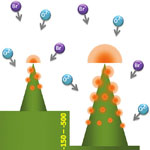 In recent years various bottom-up processes (such as growth techniques) and top-down processes (such as electron beam, lithography, nanoimprint) have been used to produce one dimensional nanostructure on semiconductor substrate. All these approaches involve nanoscale prepatterning or extreme fabrication conditions; hence, they are often limited by associated high cost and low yield. In a novel nanomanufacturing process known as Simultaneous Plasma-Enhanced Reactive Ion Synthesis and Etching (SPERISE), researchers have integrated both nanoscale bottom-up synthetic and top-down etching approach. This eliminates the expensive prepatterning steps and hence give rise to ultrahigh throughput, better reliability, high yield and above all, low cost.
In recent years various bottom-up processes (such as growth techniques) and top-down processes (such as electron beam, lithography, nanoimprint) have been used to produce one dimensional nanostructure on semiconductor substrate. All these approaches involve nanoscale prepatterning or extreme fabrication conditions; hence, they are often limited by associated high cost and low yield. In a novel nanomanufacturing process known as Simultaneous Plasma-Enhanced Reactive Ion Synthesis and Etching (SPERISE), researchers have integrated both nanoscale bottom-up synthetic and top-down etching approach. This eliminates the expensive prepatterning steps and hence give rise to ultrahigh throughput, better reliability, high yield and above all, low cost.
Oct 3rd, 2011
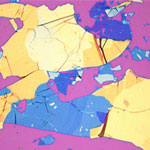 Carbon nanotubes (CNTs) have not yet met commercial expectations from a decade ago, and now hot on its heels is graphene. Graphene is considered a hot candidate for applications such as computers, displays, photovoltaics, and flexible electronics. The biggest opportunity for both materials is in printed and potentially printed electronics. In a comparably short time a large amount of graphene materials have become commercially available contributing to further advancements and application development. At a fraction of the weight and cost of CNTs, graphene may displace carbon nanotubes and even indium tin oxide in some applications. Flexible, see-through displays may be the one application that finally puts graphene into the commercial spotlight.
Carbon nanotubes (CNTs) have not yet met commercial expectations from a decade ago, and now hot on its heels is graphene. Graphene is considered a hot candidate for applications such as computers, displays, photovoltaics, and flexible electronics. The biggest opportunity for both materials is in printed and potentially printed electronics. In a comparably short time a large amount of graphene materials have become commercially available contributing to further advancements and application development. At a fraction of the weight and cost of CNTs, graphene may displace carbon nanotubes and even indium tin oxide in some applications. Flexible, see-through displays may be the one application that finally puts graphene into the commercial spotlight.
Sep 28th, 2011
 Despites huge research funding for photovoltaics, contribution of solar cells to energy market is still negligible. The major obstacle is high production cost of silicon solar cells: current solar cell market is dominated by silicon technology. Bulky and rigid silicon solar cell with a power conversion efficiency above 10% and a lifetime of 25 years have become the benchmark in photovoltaic industry. However, there are plenty of scopes for disposable and inexpensive solar cells with a moderate efficiency and a shorter lifetime, which can be compared with plant leaves with a typical efficiency of 3-7% and a lifetime less than a year. Here is an example of research that was motivated to produce cheap and disposable solar cells with a moderate power conversion efficiency.
Despites huge research funding for photovoltaics, contribution of solar cells to energy market is still negligible. The major obstacle is high production cost of silicon solar cells: current solar cell market is dominated by silicon technology. Bulky and rigid silicon solar cell with a power conversion efficiency above 10% and a lifetime of 25 years have become the benchmark in photovoltaic industry. However, there are plenty of scopes for disposable and inexpensive solar cells with a moderate efficiency and a shorter lifetime, which can be compared with plant leaves with a typical efficiency of 3-7% and a lifetime less than a year. Here is an example of research that was motivated to produce cheap and disposable solar cells with a moderate power conversion efficiency.
Sep 26th, 2011
 Today we are going to tackle a general topic that deals with how data is represented in scientific papers. The use of illustrations in scientifi c publications is a longstanding tradition that goes back thousands of years. In the course of writing 1,200 Nanowerk Spotlights over the past six years, we have worked our way through thousands of papers. And if one thing has stood out, it is the quality of the illustrations included in these papers: some are just excellent and capture the essence of the findings; others, well, let's just say they could be improved upon. Here are five specific recommendations on how scientists should design effective figures.
Today we are going to tackle a general topic that deals with how data is represented in scientific papers. The use of illustrations in scientifi c publications is a longstanding tradition that goes back thousands of years. In the course of writing 1,200 Nanowerk Spotlights over the past six years, we have worked our way through thousands of papers. And if one thing has stood out, it is the quality of the illustrations included in these papers: some are just excellent and capture the essence of the findings; others, well, let's just say they could be improved upon. Here are five specific recommendations on how scientists should design effective figures.
Sep 22nd, 2011
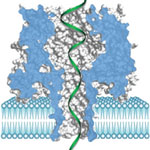 Every aspect of cellular activities, including cell proliferation, differentiation, metabolism and apoptosis, can be regulated by a class of tiny but very important nucleic acids fragments called microRNAs (miRNAs). They bind to specific messenger RNAs and cause messenger RNA degradation or inhibit translation, thereby regulate gene expression at the post-translational level. In cancer cells, the homeostasis of these normal biological processes is disrupted, partially by dysregulated miRNAs, therefore the level of microRNAs is an indicator to the disease development, and miRNAs in cancer tissues or biofluids can be utilized as a diagnostic biomarker for cancer detection. Now, researchers report a miRNAs-based discovery that could provide a much earlier warning signal for lung cancer.
Every aspect of cellular activities, including cell proliferation, differentiation, metabolism and apoptosis, can be regulated by a class of tiny but very important nucleic acids fragments called microRNAs (miRNAs). They bind to specific messenger RNAs and cause messenger RNA degradation or inhibit translation, thereby regulate gene expression at the post-translational level. In cancer cells, the homeostasis of these normal biological processes is disrupted, partially by dysregulated miRNAs, therefore the level of microRNAs is an indicator to the disease development, and miRNAs in cancer tissues or biofluids can be utilized as a diagnostic biomarker for cancer detection. Now, researchers report a miRNAs-based discovery that could provide a much earlier warning signal for lung cancer.
Sep 20th, 2011
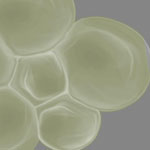 Along with graphene, atomically thin sheets and ribbons of boron nitride (often called "white graphene") have increasingly attracted fundamental research interest. While researchers make good progress on developing techniques for mass-producing graphene, it is still a challenge to reliably chemically delaminate and/or exfoliate boron nitride and to realize mass production of atomically thin sheets made of this material. Researchers in Japan have now reported a new approach for synthesizing boron nitride monolayers which pretty much works like blowing a balloon; although these balloons are sized in a range of tens of micrometers. The new technique solves the problem of low-throughput fabrication of 2D crystals.
Along with graphene, atomically thin sheets and ribbons of boron nitride (often called "white graphene") have increasingly attracted fundamental research interest. While researchers make good progress on developing techniques for mass-producing graphene, it is still a challenge to reliably chemically delaminate and/or exfoliate boron nitride and to realize mass production of atomically thin sheets made of this material. Researchers in Japan have now reported a new approach for synthesizing boron nitride monolayers which pretty much works like blowing a balloon; although these balloons are sized in a range of tens of micrometers. The new technique solves the problem of low-throughput fabrication of 2D crystals.
Sep 19th, 2011
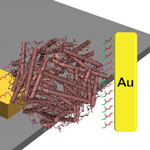 Memristors - the fourth fundamental two-terminal circuit element following the resistor, the capacitor, and the inductor - have attracted intensive attention owing to their potential applications for instance in nanoelectronic memories, computer logic, or neuromorphic computer architectures. Scientists have been able to show that various materials such as metal oxides, chalcogenides, amorphous silicon, carbon, and polymer-nanoparticle composite materials exhibit memristive phenomena. One unanswered question so far has been whether natural biomaterials like proteins can be used for the fabrication of solid-state devices with transport junctions. Researchers in Singapore have now demonstrated that proteins indeed can be used to fabricate bipolar memristive nanodevices.
Memristors - the fourth fundamental two-terminal circuit element following the resistor, the capacitor, and the inductor - have attracted intensive attention owing to their potential applications for instance in nanoelectronic memories, computer logic, or neuromorphic computer architectures. Scientists have been able to show that various materials such as metal oxides, chalcogenides, amorphous silicon, carbon, and polymer-nanoparticle composite materials exhibit memristive phenomena. One unanswered question so far has been whether natural biomaterials like proteins can be used for the fabrication of solid-state devices with transport junctions. Researchers in Singapore have now demonstrated that proteins indeed can be used to fabricate bipolar memristive nanodevices.
Sep 16th, 2011
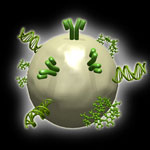 Bio-conjugated nanoparticles are important analytical tools with emerging biological and medical applications. Especially gold nanoparticles are of increasing interest for nanobiotechnology research and applications because of their high acceptance level in living systems and the fact that they are fairly easily conjugated with functional molecules. Ultrashort pulsed laser ablation represents a powerful tool for the generation of pure gold nanoparticles avoiding chemical precursors, reducing agents, and stabilizing ligands. The bare surface of the charged nanoparticles makes them highly available for functionalization and as a result especially interesting for biomedical applications. Starting today, such conjugates are available commercially for the first time.
Bio-conjugated nanoparticles are important analytical tools with emerging biological and medical applications. Especially gold nanoparticles are of increasing interest for nanobiotechnology research and applications because of their high acceptance level in living systems and the fact that they are fairly easily conjugated with functional molecules. Ultrashort pulsed laser ablation represents a powerful tool for the generation of pure gold nanoparticles avoiding chemical precursors, reducing agents, and stabilizing ligands. The bare surface of the charged nanoparticles makes them highly available for functionalization and as a result especially interesting for biomedical applications. Starting today, such conjugates are available commercially for the first time.
Sep 15th, 2011
 In recent years various bottom-up processes (such as growth techniques) and top-down processes (such as electron beam, lithography, nanoimprint) have been used to produce one dimensional nanostructure on semiconductor substrate. All these approaches involve nanoscale prepatterning or extreme fabrication conditions; hence, they are often limited by associated high cost and low yield. In a novel nanomanufacturing process known as Simultaneous Plasma-Enhanced Reactive Ion Synthesis and Etching (SPERISE), researchers have integrated both nanoscale bottom-up synthetic and top-down etching approach. This eliminates the expensive prepatterning steps and hence give rise to ultrahigh throughput, better reliability, high yield and above all, low cost.
In recent years various bottom-up processes (such as growth techniques) and top-down processes (such as electron beam, lithography, nanoimprint) have been used to produce one dimensional nanostructure on semiconductor substrate. All these approaches involve nanoscale prepatterning or extreme fabrication conditions; hence, they are often limited by associated high cost and low yield. In a novel nanomanufacturing process known as Simultaneous Plasma-Enhanced Reactive Ion Synthesis and Etching (SPERISE), researchers have integrated both nanoscale bottom-up synthetic and top-down etching approach. This eliminates the expensive prepatterning steps and hence give rise to ultrahigh throughput, better reliability, high yield and above all, low cost.
 Subscribe to our Nanotechnology Spotlight feed
Subscribe to our Nanotechnology Spotlight feed





